Report: Analyzing Tesco's Strategic Planning and Implementation
VerifiedAdded on 2020/01/21
|19
|4055
|1169
Report
AI Summary
This report provides a comprehensive analysis of Tesco's strategic planning process. It begins by outlining the company's mission, vision, objectives, and core competencies. The report then delves into the strategic planning process, examining factors such as market analysis, customer needs, and competitive advantage. It explores techniques like the BCG growth-share matrix, Ansoff's growth-vector matrix, and portfolio analysis. The report further evaluates Tesco's internal environment through SWOT and value chain analyses, highlighting its strengths, weaknesses, opportunities, and threats. Finally, the report conducts an environmental audit using PESTLE and Porter's Five Forces models to assess the external factors impacting Tesco's business. This report provides a detailed understanding of the strategic decisions made by Tesco and the tools used to achieve its goals.

UNDERSTAND THE
PROCESS OF
STRATEGIC
PLANNING
PROCESS OF
STRATEGIC
PLANNING
Paraphrase This Document
Need a fresh take? Get an instant paraphrase of this document with our AI Paraphraser

TABLE OF CONTENTS
INTRODUCTION...........................................................................................................................3
TASK 1............................................................................................................................................3
1.1................................................................................................................................................3
1.2................................................................................................................................................5
1.3................................................................................................................................................6
TASK 2............................................................................................................................................6
2.1................................................................................................................................................6
2.2................................................................................................................................................8
2.3................................................................................................................................................1
2.4................................................................................................................................................3
CONCLUSION................................................................................................................................4
REFERENCES ...............................................................................................................................5
INTRODUCTION...........................................................................................................................3
TASK 1............................................................................................................................................3
1.1................................................................................................................................................3
1.2................................................................................................................................................5
1.3................................................................................................................................................6
TASK 2............................................................................................................................................6
2.1................................................................................................................................................6
2.2................................................................................................................................................8
2.3................................................................................................................................................1
2.4................................................................................................................................................3
CONCLUSION................................................................................................................................4
REFERENCES ...............................................................................................................................5

INTRODUCTION
In today's era planning is very important part for the organisation and its will assist for
the business running in very smooth way. Strategic planning is a necessary point for standing in
the competitive environment. In this set budgets, planning or forecasting for the business is very
crucial part. It will assists for the process of the organisation (Cheng, 2013).
Present case study is on Tesco and about its strategic planning process. It is a UK based
company who deals in the grocery products in the very large scale. In this mission, vision and so
on are described in this. Company has also focused on its future goals and needs of the customer.
Furthermore in this research every possible techniques used in this to groom the business in the
very effective manner (Longoni and Cagliano, 2015).
TASK 1
1.1
For every business task achievement a strategic planning is necessary for research for the
future. With the help this systematic planning Tesco evaluates its objectives and find all
available ways to grab them (Elhamma and Zhang, 2013). In addition ton that various activities
are done by the management of Tesco and this are listed as follows:
Mission: In the very initial stage of the planning Tesco has to set a mission towards its
customers that is for their whole life they want to earn loyalty from their customers. In addition
to that company has to reach or expand its business in the world wide with one of the leading
brand and has provide a different shopping experience with the Tesco.
Visions: Tesco set various mission to accomplish their mission that is satisfy their
customer in that way so they automatically leads to enhancing loyalty of customers towards the
In today's era planning is very important part for the organisation and its will assist for
the business running in very smooth way. Strategic planning is a necessary point for standing in
the competitive environment. In this set budgets, planning or forecasting for the business is very
crucial part. It will assists for the process of the organisation (Cheng, 2013).
Present case study is on Tesco and about its strategic planning process. It is a UK based
company who deals in the grocery products in the very large scale. In this mission, vision and so
on are described in this. Company has also focused on its future goals and needs of the customer.
Furthermore in this research every possible techniques used in this to groom the business in the
very effective manner (Longoni and Cagliano, 2015).
TASK 1
1.1
For every business task achievement a strategic planning is necessary for research for the
future. With the help this systematic planning Tesco evaluates its objectives and find all
available ways to grab them (Elhamma and Zhang, 2013). In addition ton that various activities
are done by the management of Tesco and this are listed as follows:
Mission: In the very initial stage of the planning Tesco has to set a mission towards its
customers that is for their whole life they want to earn loyalty from their customers. In addition
to that company has to reach or expand its business in the world wide with one of the leading
brand and has provide a different shopping experience with the Tesco.
Visions: Tesco set various mission to accomplish their mission that is satisfy their
customer in that way so they automatically leads to enhancing loyalty of customers towards the
⊘ This is a preview!⊘
Do you want full access?
Subscribe today to unlock all pages.

Trusted by 1+ million students worldwide

organisation. To accomplish all mission company has to put their efforts and here vision of
Tesco is listed as follows:
Tesco set best perception in the customers and its all stakeholder mind that they are serve
the best one (Feranado, 2011).
In this company wants to move towards the modernity with various innovation so it will
assists to enhance the loyalty of the customer. Entity use this skills in the world wide so that globally enhance the work.
Objectives: Tesco wants to expand their business in the world wide so that management
of the company must set some objectives towards the customer evaluation and this are listed as
follows:
For standing in the international market Tesco must understand its customers needs and
want according their culture because in every country customers test and their perception
about the product is totally different (Milne and Gray, 2013).
Management must set their prioritise in customers point of view. Tesco management encourage their worker to work as a team and support each other so it
will assists for the mutual respect among them.
Goals: Tesco plc has to set that they can achieve their set target within a 5 years. This
years Tesco committing that company enhance their sales upto £1 Billion so that entity became
more effective to invest in the business world wide. Another desire of the Tesco is that become a
successful retailer in the international market.
Core competencies: Core competencies is a skill or ability of Tesco that differentiate
from the other organisation. Tesco use various strategies that is only focuses on its customer and
their satisfaction. In addition to that Tesco adopt various information system that assist to easily
provide its services in the local market. Companies effectively full fill its demand and supply
system is giving to stand in the market for the long time (Collins-Camargo, Armstrong,
McBeath and Chuang, 2013).
1.2
When Tesco considered its strategies planning various analysis and factors must be
evaluated. So that it reduces the ratio of problems that may be occurs in the future and this
factors are listed as follows:
Tesco is listed as follows:
Tesco set best perception in the customers and its all stakeholder mind that they are serve
the best one (Feranado, 2011).
In this company wants to move towards the modernity with various innovation so it will
assists to enhance the loyalty of the customer. Entity use this skills in the world wide so that globally enhance the work.
Objectives: Tesco wants to expand their business in the world wide so that management
of the company must set some objectives towards the customer evaluation and this are listed as
follows:
For standing in the international market Tesco must understand its customers needs and
want according their culture because in every country customers test and their perception
about the product is totally different (Milne and Gray, 2013).
Management must set their prioritise in customers point of view. Tesco management encourage their worker to work as a team and support each other so it
will assists for the mutual respect among them.
Goals: Tesco plc has to set that they can achieve their set target within a 5 years. This
years Tesco committing that company enhance their sales upto £1 Billion so that entity became
more effective to invest in the business world wide. Another desire of the Tesco is that become a
successful retailer in the international market.
Core competencies: Core competencies is a skill or ability of Tesco that differentiate
from the other organisation. Tesco use various strategies that is only focuses on its customer and
their satisfaction. In addition to that Tesco adopt various information system that assist to easily
provide its services in the local market. Companies effectively full fill its demand and supply
system is giving to stand in the market for the long time (Collins-Camargo, Armstrong,
McBeath and Chuang, 2013).
1.2
When Tesco considered its strategies planning various analysis and factors must be
evaluated. So that it reduces the ratio of problems that may be occurs in the future and this
factors are listed as follows:
Paraphrase This Document
Need a fresh take? Get an instant paraphrase of this document with our AI Paraphraser
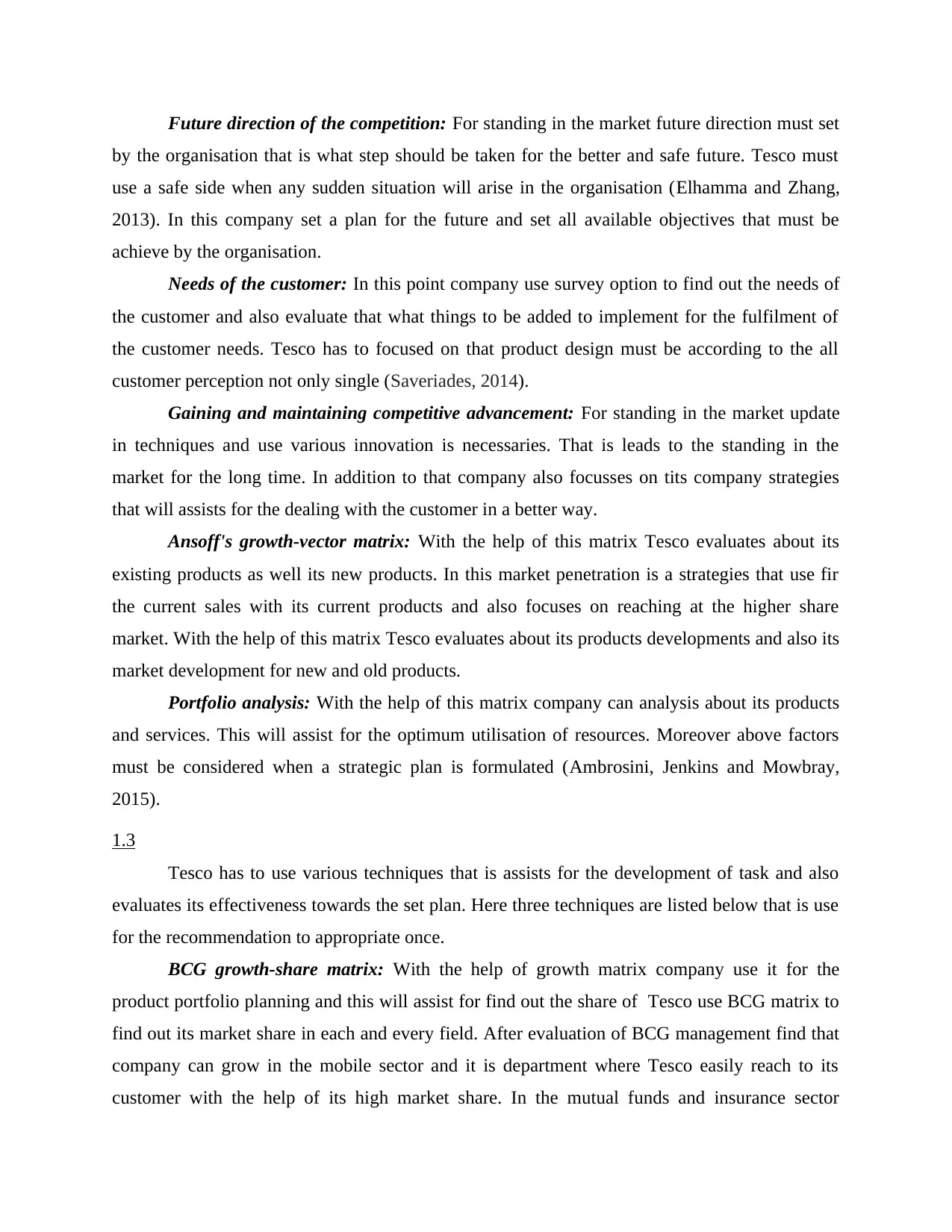
Future direction of the competition: For standing in the market future direction must set
by the organisation that is what step should be taken for the better and safe future. Tesco must
use a safe side when any sudden situation will arise in the organisation (Elhamma and Zhang,
2013). In this company set a plan for the future and set all available objectives that must be
achieve by the organisation.
Needs of the customer: In this point company use survey option to find out the needs of
the customer and also evaluate that what things to be added to implement for the fulfilment of
the customer needs. Tesco has to focused on that product design must be according to the all
customer perception not only single (Saveriades, 2014).
Gaining and maintaining competitive advancement: For standing in the market update
in techniques and use various innovation is necessaries. That is leads to the standing in the
market for the long time. In addition to that company also focusses on tits company strategies
that will assists for the dealing with the customer in a better way.
Ansoff's growth-vector matrix: With the help of this matrix Tesco evaluates about its
existing products as well its new products. In this market penetration is a strategies that use fir
the current sales with its current products and also focuses on reaching at the higher share
market. With the help of this matrix Tesco evaluates about its products developments and also its
market development for new and old products.
Portfolio analysis: With the help of this matrix company can analysis about its products
and services. This will assist for the optimum utilisation of resources. Moreover above factors
must be considered when a strategic plan is formulated (Ambrosini, Jenkins and Mowbray,
2015).
1.3
Tesco has to use various techniques that is assists for the development of task and also
evaluates its effectiveness towards the set plan. Here three techniques are listed below that is use
for the recommendation to appropriate once.
BCG growth-share matrix: With the help of growth matrix company use it for the
product portfolio planning and this will assist for find out the share of Tesco use BCG matrix to
find out its market share in each and every field. After evaluation of BCG management find that
company can grow in the mobile sector and it is department where Tesco easily reach to its
customer with the help of its high market share. In the mutual funds and insurance sector
by the organisation that is what step should be taken for the better and safe future. Tesco must
use a safe side when any sudden situation will arise in the organisation (Elhamma and Zhang,
2013). In this company set a plan for the future and set all available objectives that must be
achieve by the organisation.
Needs of the customer: In this point company use survey option to find out the needs of
the customer and also evaluate that what things to be added to implement for the fulfilment of
the customer needs. Tesco has to focused on that product design must be according to the all
customer perception not only single (Saveriades, 2014).
Gaining and maintaining competitive advancement: For standing in the market update
in techniques and use various innovation is necessaries. That is leads to the standing in the
market for the long time. In addition to that company also focusses on tits company strategies
that will assists for the dealing with the customer in a better way.
Ansoff's growth-vector matrix: With the help of this matrix Tesco evaluates about its
existing products as well its new products. In this market penetration is a strategies that use fir
the current sales with its current products and also focuses on reaching at the higher share
market. With the help of this matrix Tesco evaluates about its products developments and also its
market development for new and old products.
Portfolio analysis: With the help of this matrix company can analysis about its products
and services. This will assist for the optimum utilisation of resources. Moreover above factors
must be considered when a strategic plan is formulated (Ambrosini, Jenkins and Mowbray,
2015).
1.3
Tesco has to use various techniques that is assists for the development of task and also
evaluates its effectiveness towards the set plan. Here three techniques are listed below that is use
for the recommendation to appropriate once.
BCG growth-share matrix: With the help of growth matrix company use it for the
product portfolio planning and this will assist for find out the share of Tesco use BCG matrix to
find out its market share in each and every field. After evaluation of BCG management find that
company can grow in the mobile sector and it is department where Tesco easily reach to its
customer with the help of its high market share. In the mutual funds and insurance sector
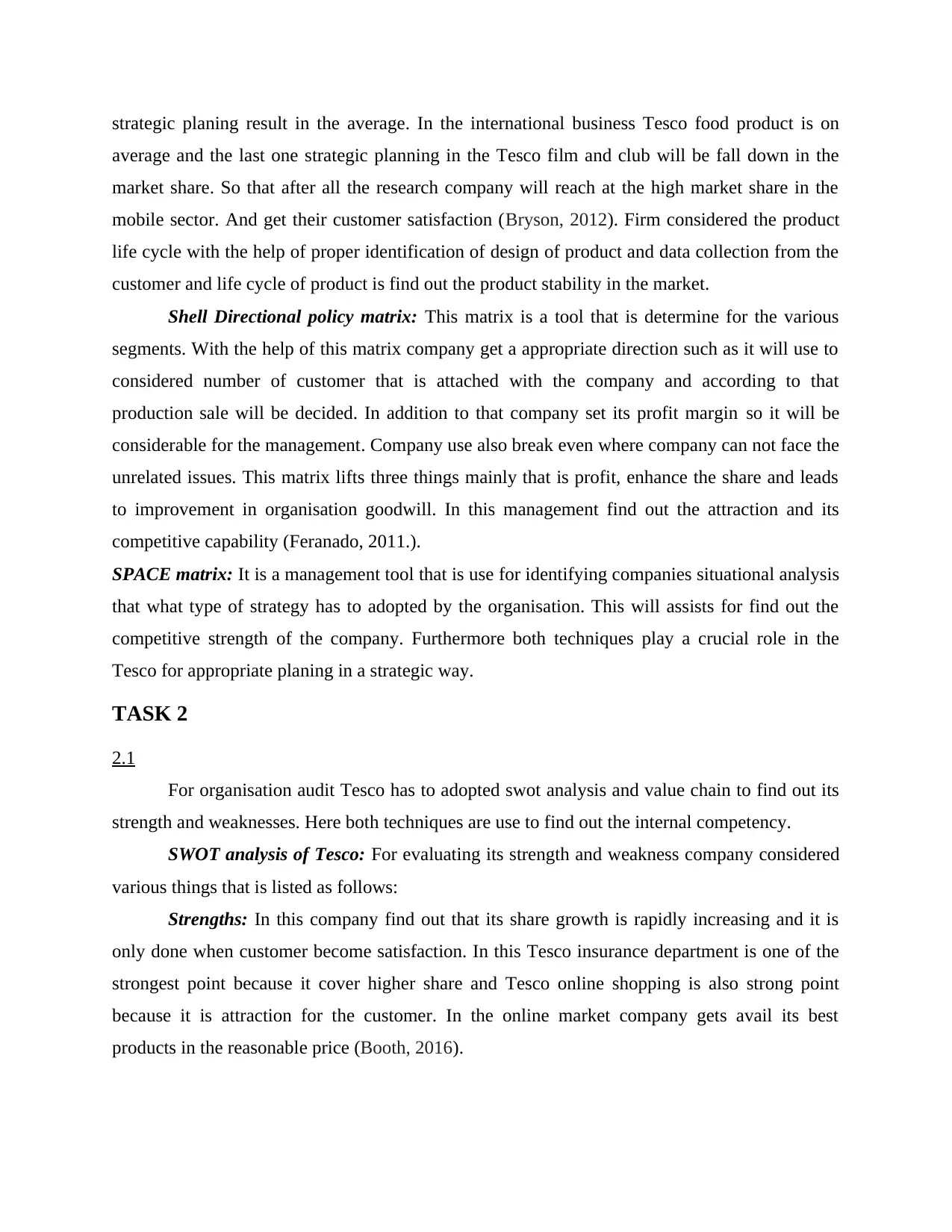
strategic planing result in the average. In the international business Tesco food product is on
average and the last one strategic planning in the Tesco film and club will be fall down in the
market share. So that after all the research company will reach at the high market share in the
mobile sector. And get their customer satisfaction (Bryson, 2012). Firm considered the product
life cycle with the help of proper identification of design of product and data collection from the
customer and life cycle of product is find out the product stability in the market.
Shell Directional policy matrix: This matrix is a tool that is determine for the various
segments. With the help of this matrix company get a appropriate direction such as it will use to
considered number of customer that is attached with the company and according to that
production sale will be decided. In addition to that company set its profit margin so it will be
considerable for the management. Company use also break even where company can not face the
unrelated issues. This matrix lifts three things mainly that is profit, enhance the share and leads
to improvement in organisation goodwill. In this management find out the attraction and its
competitive capability (Feranado, 2011.).
SPACE matrix: It is a management tool that is use for identifying companies situational analysis
that what type of strategy has to adopted by the organisation. This will assists for find out the
competitive strength of the company. Furthermore both techniques play a crucial role in the
Tesco for appropriate planing in a strategic way.
TASK 2
2.1
For organisation audit Tesco has to adopted swot analysis and value chain to find out its
strength and weaknesses. Here both techniques are use to find out the internal competency.
SWOT analysis of Tesco: For evaluating its strength and weakness company considered
various things that is listed as follows:
Strengths: In this company find out that its share growth is rapidly increasing and it is
only done when customer become satisfaction. In this Tesco insurance department is one of the
strongest point because it cover higher share and Tesco online shopping is also strong point
because it is attraction for the customer. In the online market company gets avail its best
products in the reasonable price (Booth, 2016).
average and the last one strategic planning in the Tesco film and club will be fall down in the
market share. So that after all the research company will reach at the high market share in the
mobile sector. And get their customer satisfaction (Bryson, 2012). Firm considered the product
life cycle with the help of proper identification of design of product and data collection from the
customer and life cycle of product is find out the product stability in the market.
Shell Directional policy matrix: This matrix is a tool that is determine for the various
segments. With the help of this matrix company get a appropriate direction such as it will use to
considered number of customer that is attached with the company and according to that
production sale will be decided. In addition to that company set its profit margin so it will be
considerable for the management. Company use also break even where company can not face the
unrelated issues. This matrix lifts three things mainly that is profit, enhance the share and leads
to improvement in organisation goodwill. In this management find out the attraction and its
competitive capability (Feranado, 2011.).
SPACE matrix: It is a management tool that is use for identifying companies situational analysis
that what type of strategy has to adopted by the organisation. This will assists for find out the
competitive strength of the company. Furthermore both techniques play a crucial role in the
Tesco for appropriate planing in a strategic way.
TASK 2
2.1
For organisation audit Tesco has to adopted swot analysis and value chain to find out its
strength and weaknesses. Here both techniques are use to find out the internal competency.
SWOT analysis of Tesco: For evaluating its strength and weakness company considered
various things that is listed as follows:
Strengths: In this company find out that its share growth is rapidly increasing and it is
only done when customer become satisfaction. In this Tesco insurance department is one of the
strongest point because it cover higher share and Tesco online shopping is also strong point
because it is attraction for the customer. In the online market company gets avail its best
products in the reasonable price (Booth, 2016).
⊘ This is a preview!⊘
Do you want full access?
Subscribe today to unlock all pages.

Trusted by 1+ million students worldwide
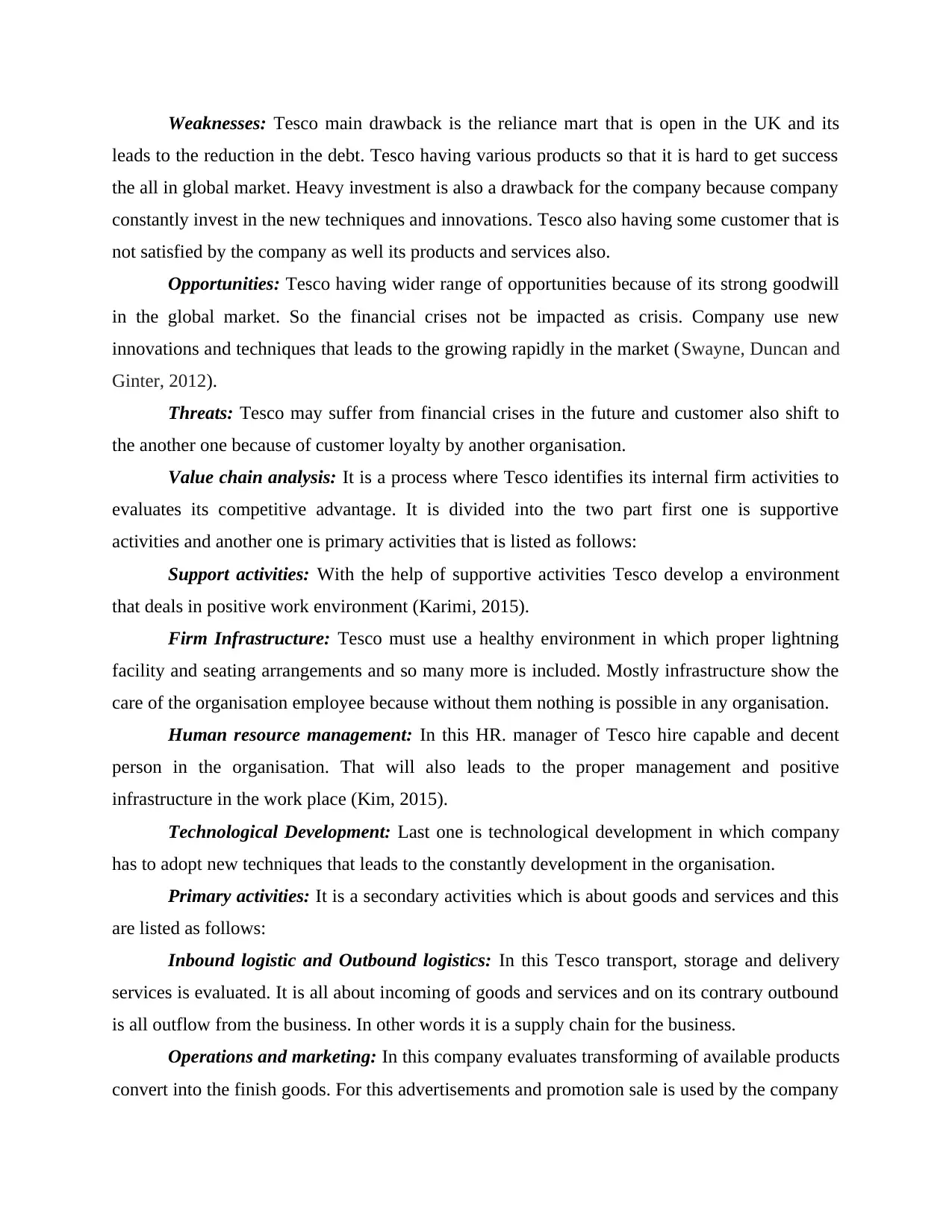
Weaknesses: Tesco main drawback is the reliance mart that is open in the UK and its
leads to the reduction in the debt. Tesco having various products so that it is hard to get success
the all in global market. Heavy investment is also a drawback for the company because company
constantly invest in the new techniques and innovations. Tesco also having some customer that is
not satisfied by the company as well its products and services also.
Opportunities: Tesco having wider range of opportunities because of its strong goodwill
in the global market. So the financial crises not be impacted as crisis. Company use new
innovations and techniques that leads to the growing rapidly in the market (Swayne, Duncan and
Ginter, 2012).
Threats: Tesco may suffer from financial crises in the future and customer also shift to
the another one because of customer loyalty by another organisation.
Value chain analysis: It is a process where Tesco identifies its internal firm activities to
evaluates its competitive advantage. It is divided into the two part first one is supportive
activities and another one is primary activities that is listed as follows:
Support activities: With the help of supportive activities Tesco develop a environment
that deals in positive work environment (Karimi, 2015).
Firm Infrastructure: Tesco must use a healthy environment in which proper lightning
facility and seating arrangements and so many more is included. Mostly infrastructure show the
care of the organisation employee because without them nothing is possible in any organisation.
Human resource management: In this HR. manager of Tesco hire capable and decent
person in the organisation. That will also leads to the proper management and positive
infrastructure in the work place (Kim, 2015).
Technological Development: Last one is technological development in which company
has to adopt new techniques that leads to the constantly development in the organisation.
Primary activities: It is a secondary activities which is about goods and services and this
are listed as follows:
Inbound logistic and Outbound logistics: In this Tesco transport, storage and delivery
services is evaluated. It is all about incoming of goods and services and on its contrary outbound
is all outflow from the business. In other words it is a supply chain for the business.
Operations and marketing: In this company evaluates transforming of available products
convert into the finish goods. For this advertisements and promotion sale is used by the company
leads to the reduction in the debt. Tesco having various products so that it is hard to get success
the all in global market. Heavy investment is also a drawback for the company because company
constantly invest in the new techniques and innovations. Tesco also having some customer that is
not satisfied by the company as well its products and services also.
Opportunities: Tesco having wider range of opportunities because of its strong goodwill
in the global market. So the financial crises not be impacted as crisis. Company use new
innovations and techniques that leads to the growing rapidly in the market (Swayne, Duncan and
Ginter, 2012).
Threats: Tesco may suffer from financial crises in the future and customer also shift to
the another one because of customer loyalty by another organisation.
Value chain analysis: It is a process where Tesco identifies its internal firm activities to
evaluates its competitive advantage. It is divided into the two part first one is supportive
activities and another one is primary activities that is listed as follows:
Support activities: With the help of supportive activities Tesco develop a environment
that deals in positive work environment (Karimi, 2015).
Firm Infrastructure: Tesco must use a healthy environment in which proper lightning
facility and seating arrangements and so many more is included. Mostly infrastructure show the
care of the organisation employee because without them nothing is possible in any organisation.
Human resource management: In this HR. manager of Tesco hire capable and decent
person in the organisation. That will also leads to the proper management and positive
infrastructure in the work place (Kim, 2015).
Technological Development: Last one is technological development in which company
has to adopt new techniques that leads to the constantly development in the organisation.
Primary activities: It is a secondary activities which is about goods and services and this
are listed as follows:
Inbound logistic and Outbound logistics: In this Tesco transport, storage and delivery
services is evaluated. It is all about incoming of goods and services and on its contrary outbound
is all outflow from the business. In other words it is a supply chain for the business.
Operations and marketing: In this company evaluates transforming of available products
convert into the finish goods. For this advertisements and promotion sale is used by the company
Paraphrase This Document
Need a fresh take? Get an instant paraphrase of this document with our AI Paraphraser
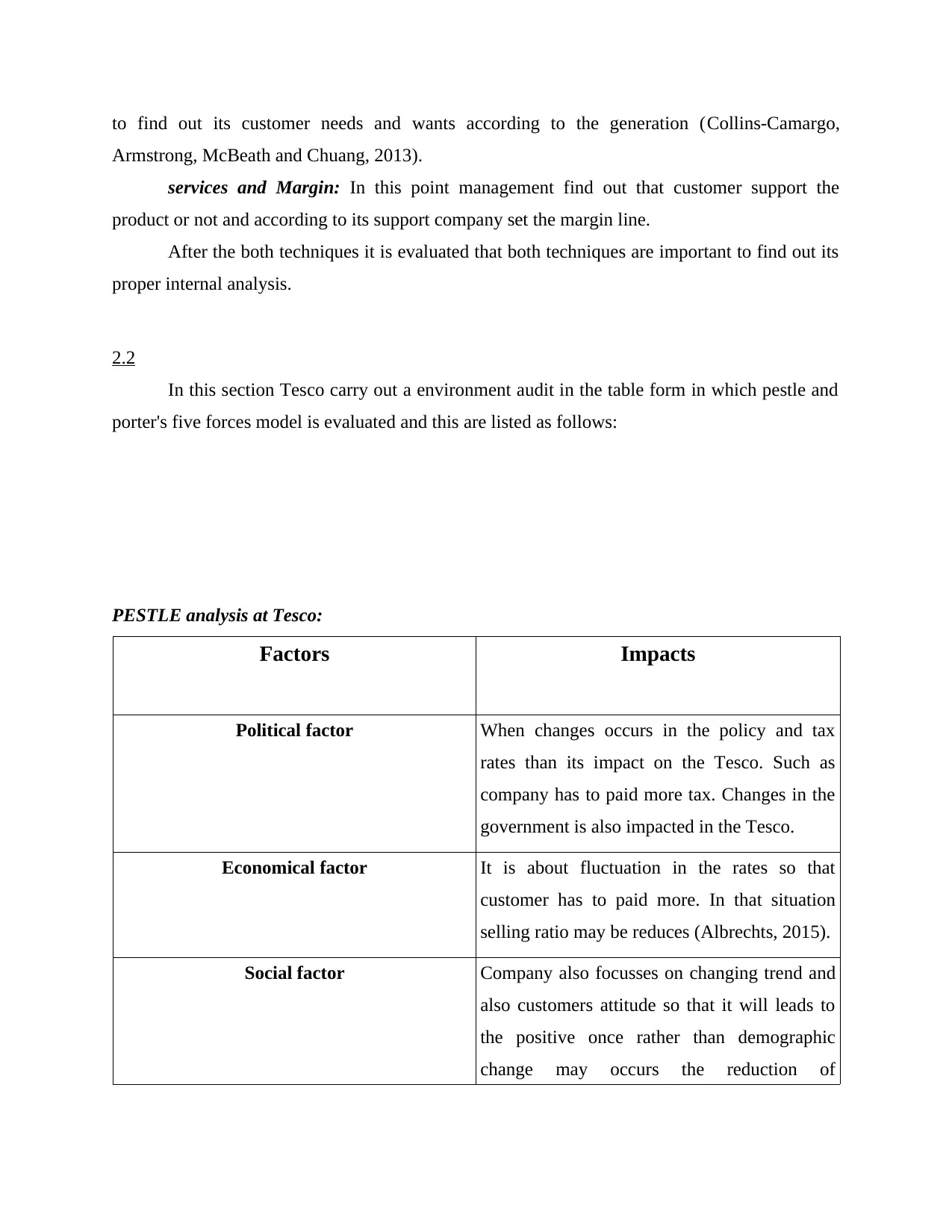
to find out its customer needs and wants according to the generation (Collins-Camargo,
Armstrong, McBeath and Chuang, 2013).
services and Margin: In this point management find out that customer support the
product or not and according to its support company set the margin line.
After the both techniques it is evaluated that both techniques are important to find out its
proper internal analysis.
2.2
In this section Tesco carry out a environment audit in the table form in which pestle and
porter's five forces model is evaluated and this are listed as follows:
PESTLE analysis at Tesco:
Factors Impacts
Political factor When changes occurs in the policy and tax
rates than its impact on the Tesco. Such as
company has to paid more tax. Changes in the
government is also impacted in the Tesco.
Economical factor It is about fluctuation in the rates so that
customer has to paid more. In that situation
selling ratio may be reduces (Albrechts, 2015).
Social factor Company also focusses on changing trend and
also customers attitude so that it will leads to
the positive once rather than demographic
change may occurs the reduction of
Armstrong, McBeath and Chuang, 2013).
services and Margin: In this point management find out that customer support the
product or not and according to its support company set the margin line.
After the both techniques it is evaluated that both techniques are important to find out its
proper internal analysis.
2.2
In this section Tesco carry out a environment audit in the table form in which pestle and
porter's five forces model is evaluated and this are listed as follows:
PESTLE analysis at Tesco:
Factors Impacts
Political factor When changes occurs in the policy and tax
rates than its impact on the Tesco. Such as
company has to paid more tax. Changes in the
government is also impacted in the Tesco.
Economical factor It is about fluctuation in the rates so that
customer has to paid more. In that situation
selling ratio may be reduces (Albrechts, 2015).
Social factor Company also focusses on changing trend and
also customers attitude so that it will leads to
the positive once rather than demographic
change may occurs the reduction of

organisation goals.
Technological factor Changes in the technology is also impacted the
Tesco. If company not add any innovation that
reduce the sale. Technological innovation
refers to emergence of new technology which
tends to speed up overall business activities. It
uses different types of technology for
promoting and delivering the products and
services to end users.
Legal factor Company also focuses on various rules and
regulation that is impacted on the companies
goodwill. Production department must focuses
on the health and safety issues (Albrechts,
2015).
Environment factor In this Tesco must use that type of product that
must be recycling and not leads to the
pollution.
Porter's five forces analysis:
In this Tesco find out its bargaining power because of its goodwill company having
various supplier. So Tesco has power to select the supplier who provide best and
reasonable material (strategic planning. 2016).
In this company produces various kind of products as per their customer wants so that it
leads to the buyer attraction towards the Tesco products. In addition to that company
always focused out its new entrants in this filed.
For that company also take care of its substitute that available in the market that may
leads to the positive workforce.
Technological factor Changes in the technology is also impacted the
Tesco. If company not add any innovation that
reduce the sale. Technological innovation
refers to emergence of new technology which
tends to speed up overall business activities. It
uses different types of technology for
promoting and delivering the products and
services to end users.
Legal factor Company also focuses on various rules and
regulation that is impacted on the companies
goodwill. Production department must focuses
on the health and safety issues (Albrechts,
2015).
Environment factor In this Tesco must use that type of product that
must be recycling and not leads to the
pollution.
Porter's five forces analysis:
In this Tesco find out its bargaining power because of its goodwill company having
various supplier. So Tesco has power to select the supplier who provide best and
reasonable material (strategic planning. 2016).
In this company produces various kind of products as per their customer wants so that it
leads to the buyer attraction towards the Tesco products. In addition to that company
always focused out its new entrants in this filed.
For that company also take care of its substitute that available in the market that may
leads to the positive workforce.
⊘ This is a preview!⊘
Do you want full access?
Subscribe today to unlock all pages.

Trusted by 1+ million students worldwide
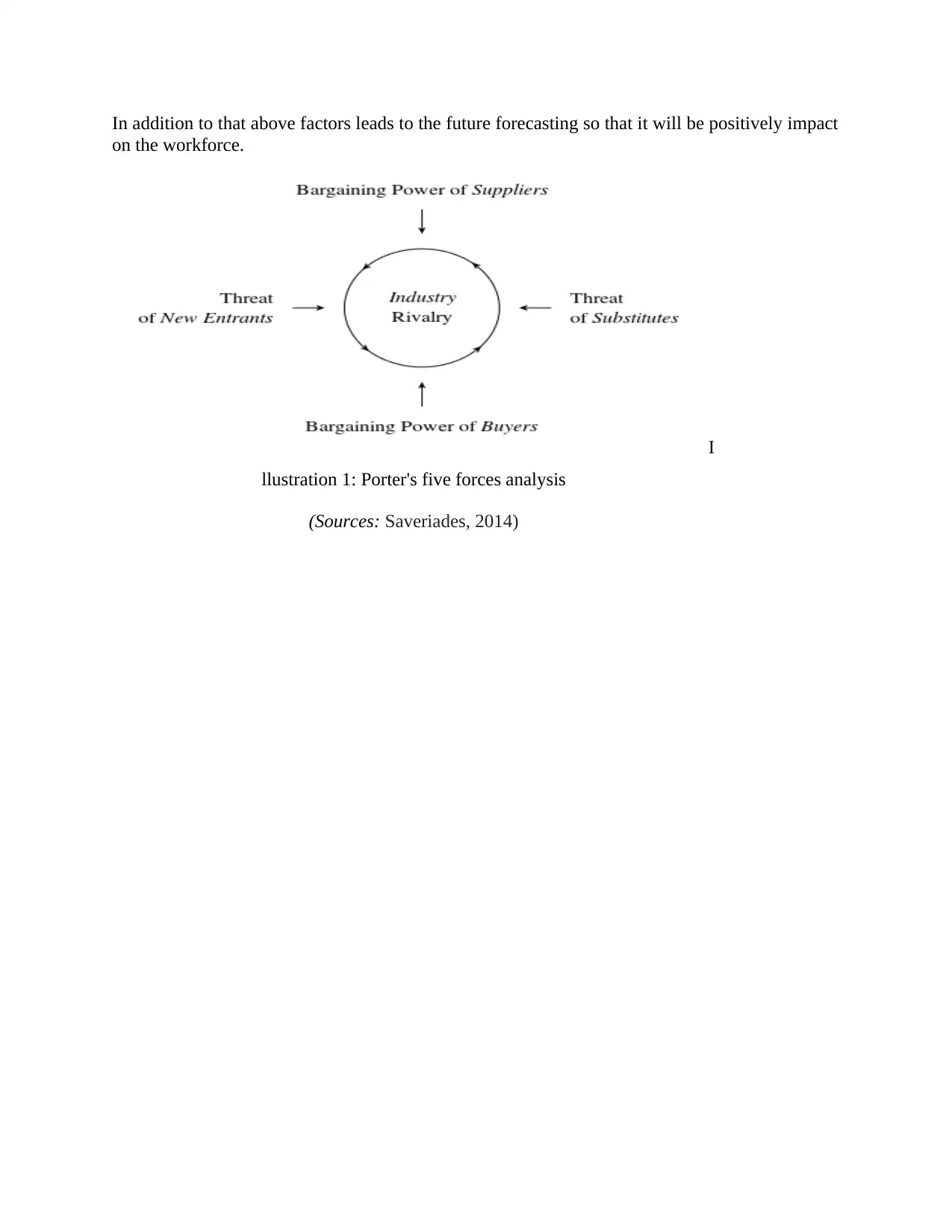
In addition to that above factors leads to the future forecasting so that it will be positively impact
on the workforce.
I
llustration 1: Porter's five forces analysis
(Sources: Saveriades, 2014)
on the workforce.
I
llustration 1: Porter's five forces analysis
(Sources: Saveriades, 2014)
Paraphrase This Document
Need a fresh take? Get an instant paraphrase of this document with our AI Paraphraser

2.3
Stakeholders are the important persons of the organization, they get directly or indirectly
affected by the activities of business unit (Milne and Gray, 2013). Tesco is the leading brand of
UK and working tremendous across the world. Stake holder analyses is the great model which
assist in defining the power and role of each associators. It shows that high power increases the
interest in the entity of stakeholder (Elhamma and Zhang, 2013). This model explains the power
and influencing capacity of the stakeholder in the cited firm and according to their interest,
company pay attention on such person.
Illustration 2: Stakeholder analyses
Source: (Longoni and Cagliano, 2015)
Stakeholders are the important persons of the organization, they get directly or indirectly
affected by the activities of business unit (Milne and Gray, 2013). Tesco is the leading brand of
UK and working tremendous across the world. Stake holder analyses is the great model which
assist in defining the power and role of each associators. It shows that high power increases the
interest in the entity of stakeholder (Elhamma and Zhang, 2013). This model explains the power
and influencing capacity of the stakeholder in the cited firm and according to their interest,
company pay attention on such person.
Illustration 2: Stakeholder analyses
Source: (Longoni and Cagliano, 2015)
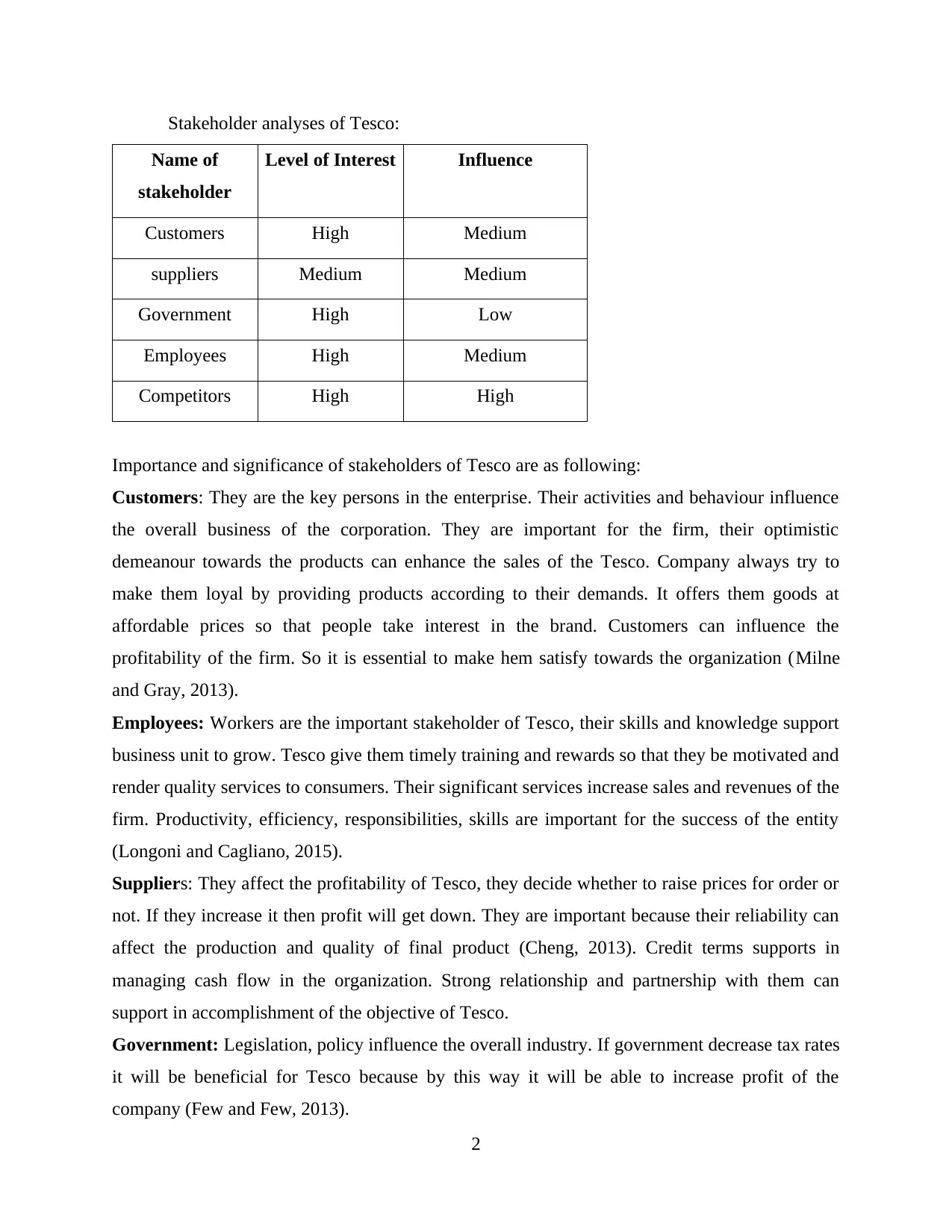
Stakeholder analyses of Tesco:
Name of
stakeholder
Level of Interest Influence
Customers High Medium
suppliers Medium Medium
Government High Low
Employees High Medium
Competitors High High
Importance and significance of stakeholders of Tesco are as following:
Customers: They are the key persons in the enterprise. Their activities and behaviour influence
the overall business of the corporation. They are important for the firm, their optimistic
demeanour towards the products can enhance the sales of the Tesco. Company always try to
make them loyal by providing products according to their demands. It offers them goods at
affordable prices so that people take interest in the brand. Customers can influence the
profitability of the firm. So it is essential to make hem satisfy towards the organization (Milne
and Gray, 2013).
Employees: Workers are the important stakeholder of Tesco, their skills and knowledge support
business unit to grow. Tesco give them timely training and rewards so that they be motivated and
render quality services to consumers. Their significant services increase sales and revenues of the
firm. Productivity, efficiency, responsibilities, skills are important for the success of the entity
(Longoni and Cagliano, 2015).
Suppliers: They affect the profitability of Tesco, they decide whether to raise prices for order or
not. If they increase it then profit will get down. They are important because their reliability can
affect the production and quality of final product (Cheng, 2013). Credit terms supports in
managing cash flow in the organization. Strong relationship and partnership with them can
support in accomplishment of the objective of Tesco.
Government: Legislation, policy influence the overall industry. If government decrease tax rates
it will be beneficial for Tesco because by this way it will be able to increase profit of the
company (Few and Few, 2013).
2
Name of
stakeholder
Level of Interest Influence
Customers High Medium
suppliers Medium Medium
Government High Low
Employees High Medium
Competitors High High
Importance and significance of stakeholders of Tesco are as following:
Customers: They are the key persons in the enterprise. Their activities and behaviour influence
the overall business of the corporation. They are important for the firm, their optimistic
demeanour towards the products can enhance the sales of the Tesco. Company always try to
make them loyal by providing products according to their demands. It offers them goods at
affordable prices so that people take interest in the brand. Customers can influence the
profitability of the firm. So it is essential to make hem satisfy towards the organization (Milne
and Gray, 2013).
Employees: Workers are the important stakeholder of Tesco, their skills and knowledge support
business unit to grow. Tesco give them timely training and rewards so that they be motivated and
render quality services to consumers. Their significant services increase sales and revenues of the
firm. Productivity, efficiency, responsibilities, skills are important for the success of the entity
(Longoni and Cagliano, 2015).
Suppliers: They affect the profitability of Tesco, they decide whether to raise prices for order or
not. If they increase it then profit will get down. They are important because their reliability can
affect the production and quality of final product (Cheng, 2013). Credit terms supports in
managing cash flow in the organization. Strong relationship and partnership with them can
support in accomplishment of the objective of Tesco.
Government: Legislation, policy influence the overall industry. If government decrease tax rates
it will be beneficial for Tesco because by this way it will be able to increase profit of the
company (Few and Few, 2013).
2
⊘ This is a preview!⊘
Do you want full access?
Subscribe today to unlock all pages.

Trusted by 1+ million students worldwide
1 out of 19
Related Documents
Your All-in-One AI-Powered Toolkit for Academic Success.
+13062052269
info@desklib.com
Available 24*7 on WhatsApp / Email
![[object Object]](/_next/static/media/star-bottom.7253800d.svg)
Unlock your academic potential
Copyright © 2020–2025 A2Z Services. All Rights Reserved. Developed and managed by ZUCOL.





